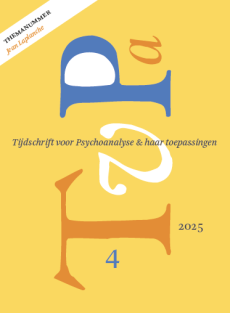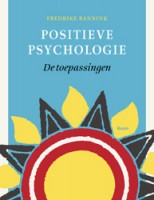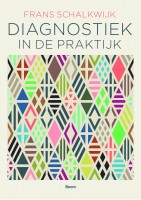Psychoanalyse: de berichten over mijn dood zijn (opnieuw) sterk overdreven
Summary
A critical examination of the work of Masling and Bornstein concerning the debate on the scientific status of psychoanalysis and the role of empirical research in this debate. Masling and Bornstein’s survey of empirical research on psychoanalysis clearly attests to the fact that psychoanalysis is alive and well more than sixty years after the death of its founder. More specifically, their series Empirical Studies of Psychoanalytic Theories shows that reiterated arguments that psychoanalysis does not have scientific status have met with an increasing response in empirical research. However, study of the work of Masling and Bornstein reveals that the dramatically increased empirical research inspired by psychoanalytic concepts and theories not only risks being one-sided but also clearly demonstrates a need for further elaboration of the philosophical and methodological underpinnings of empirical reseach in psychoanalysis.
Literatuur
- Blum, H.P. (1999), Freud at the crossing of the millennia. Journal of the American Psychoanalytic Association 47 (4), p. 1027-1035.
- Bornstein, R.F. (1988), Psychoanalysis in the undergraduate curriculum: The treatment of psychoanalytic theory in abnormal psychology texts. Psychoanalytic Psychology 5 (1), p. 83-93.
- Bornstein, R.F., en J.M. Masling (red.) (1998a), Empirical studies of psychoanalytic theories: Volume 7. Psychoanalytic perspectives on the psychoanalytic unconscious. American Psychological Association, Washington DC.
- Bornstein, R.F., en J.M. Masling (red.) (1998b), Empirical studies of psychoanalytic theories: Vol. 8. Empirical studies of the therapeutic hour. American Psychological Association, Washington DC.
- Boyd, R., P. Gasper, en J.F. Trout (red.) (1991), The philosophy of science. MIT Press, Cambridge MA.
- Cioffi, F. (1970), Freud and the idea of a pseudoscience. In: R.R. Borger en F. Cioffi (red.), Explanation in the behavioural sciences. Cambridge University Press, Londen, p. 508-5I5.
- Corveleyn, J. (1997), Discretie in diskrediet. Tijdschrift voor Psychoanalyse 3 (1), p. 7-21.
- Crews, F. (1995), The memory wars. Freud’s legacy in dispute. New York Review of Books, New York.
- Crews, F. (red.) (1998), Unauthorized Freud. Doubters confront a legend. Viking, New York.
- Crombach, H.F.M., en H.L.J.G. Merckelbach (1996), Hervonden herinneringen en andere misverstanden. Contact, Amsterdam/Antwerpen.
- Denzin, N.K., en Y.S. Lincoln (red.) (1994), Handbook of qualitative research. Sage, Londen.
- Edelson, M. (1984), Hypotheses and evidence in psychoanalysis. Chicago University Press, Chicago.
- Edelson, M. (1988), Psychoanalysis: A theory in crisis. Chicago University Press, Chicago.
- Elliott, R., C.T. Fischer en D.L. Rennie (1999), Evolving guidelines for publication of qualitative research studies in psychology and related fields. British Journal of Clinical Psychology 38, p. 215-229.
- Emde, R.N., en P. Fonagy (1997), Guest editorial. An emerging culture for psychoanalytic research? International Journal of Psychoanalysis 78, p. 643-651.
- Erdelyi, M.H. (1985), Psychoanalysis: Freud’s cognitive psychology. Freeman, New York.
- Erdelyi, M.H. (1994), Commentary: Integrating a dissociation-prone psychology. Journal of Personality 62 (4), p. 669-680.
- Eysenck, H.J. (1972), The experimental study of Freudian concepts. Bulletin of the British Psychological Society 25, p. 261-274.
- Eysenck, H.J. (1985), Decline and fall of the Freudian empire. Virago Press, Londen.
- Farrell, J. (1996), Freud’s paranoid quest. Psychoanalysis and modern suspicion. New York University Press, New York.
- Fisher, S., en R.P. Greenberg (1978), The scientific evaluation of Freud’s theories and therapy. Basic Books, New York.
- Fisher, S., en R.P. Greenberg (1985), The scientific credibility of Freud’s theories and therapy. Basic Books. New York.
- Fisher, S., en R.P. Greenberg (1996), Freud scientifically reappraised: Testing the theories and therapy. Wiley, New York.
- Forrester, J. (1996), If p, then what? Thinking in cases. History of the Human Sciences 9 (3), p. 1-25.
- Forrester, J. (1997), Dispatches from the Freud wars. Psychoanalysis and its passions. Harvard University Press, Cambridge/Londen.
- Freud, S. (1900), Die Traumdeutung. Gesammelte Werke II/III. S. Fischer, Frankfurt am Main.
- Freud, S. (1905), Drei Abhandlungen zur Sexualtheorie. Gesammelte Werke V. S. Fischer, Frankfurt am Main, p. 33-145.
- Freud, S. (1915), Die Verdrängung. Gesammelte Werke X. S. Fischer, Frankfurt am Main, p. 248-261.
- Freud, S. (1985), Briefe an Wilhelm Fließ 1887-1904. Ungekürzte Ausgabe. S. Fischer, Frankfurt am Main.
- Fridhandler, B., T.D. Eels en M.J. Horowitz (1999), Psychoanalytic explanation of pathological grief. Scientific observation of a single case. Psychoanalytic Psychology 16 (1), p. 34-57.
- Galatzer-Levy, R.M. (1991), Presentation of clinical experience. Journal of the American Psychoanalytic Association 39, p. 727-740.
- Galatzer-Levy, R.M., en S.T. Haas (1997), Psychoanalytic research: An investment in the future. Journal of the American Psychoanalytic Association 45 (1), p. 9-12.
- Grünbaum, A. (1984), The foundations of psychoanalysis. University of California Press, Berkeley CA.
- Gunderson, J.G., en G.O. Gabbard (1998), Making the case for psychoanalytic therapies in the current psychiatric environment. Journal of the American Psychoanalytic Association 47 (3), p. 679-704.
- Holt, R.R. (1992), The contemporary crises of psychoanalysis. Psychoanalysis and Contemporary Thought 15, p. 375-402.
- Holt, R.R. (1999), The literary critics take on Freud: An assessment of their critics. In: R.M. Prince (red.), The death of psychoanalysis. Murder? Suicide? Or rumor greatly exaggerated? Jason Aronson, Northvale, NJ, p. 265-304.
- Horowitz, M.J., C. Milbrath, D. Jordan, C. Stinson, D. Redington, M. Ewert, B. Fridhandler, S. Reidbord en D. Hartley (1994), Expressive and defensive behavior during discourse on unresolved topics: A single case study. Journal of Personality 62, p. 527-563.
- Horowitz, M.J., C. Stinson, B. Fridhandler, C. Milbrath, D. Redington en M. Ewert (1993), Pathological grief: An intensive case study. Psychiatry 56, p. 356-374.
- Hutjes, J.M., en J.A. van Buuren (1992), De gevalsstudie. Strategie van kwalitatief onderzoek. Boom, Meppel.
- Israëls, H. (1993), Hetgeval Freud. 1. Scheppingsverhalen. Bert Bakker, Amsterdam.
- Jones, E.E., en M. Windholz (1990), The psychoanalytic case study: Toward a method for systematic inquiry. Journal of the American Psychoanalytic Association 38, p. 985-1015.
- Kiell, N. (1988), Freud without hindsight. Reviews of his works (1893-1939). International Universities Press, Madison CT.
- Klumpner, G.H., en A. Frank (1991), On methods of reporting clinical material. Journal of the American Psychoanalytic Association 39, p. 537-551.
- Köhler, T. (1996), Anti-Freud-Literatur von ihren Anfängen bis heute. Zur wissenschaftlichen Fundierung von Psychoanalyse-Kritik. Kohlhammer, Stuttgart.
- Kuhn, T.S. (1977), The essential tension. University of Chicago Press, Chicago.
- Kvale, S. (1994), Ten standard objections to qualitative research interviews. Journal of Phenomenological Psychology 25 (2), p. 147-173.
- Lakatos, I., en A. Musgrave (red.) (1970), Criticism and the growth of knowledge. Cambridge University Press, Cambridge.
- Lietaer, H. (1996), Psychoanalyse en wetenschappelijke methode: Een bijdrage tot het Grünbaumdebat. Niet-gepubliceerd Proefschrift, Centrum voor Dieptepsychologie, Faculteit Psychologie, K.U. Leuven.
- Loftus, E., en K. Ketcham (1994), The myth of repressed memory. St. Martin’s Press, New York.
- Lothane, Z. (1996), Psychoanalytic method and the mischief of Freud bashers. Psychiatric Times, p. 48-49
- Lothane, Z. (1999), The perennial Freud: Method versus myth and the mischief of Freud bashers. International Forum of Psychoanalysis 8 (3-4), p. 151-171.
- Luborsky, L. (1986), Evidence to lessen Professor Grünbaums concern about Freud’s clinical inference method. The Behavioral and Brain Sciences 9, p. 247-249.
- Luyten, P. (1998), De Freudkritiek onder de loep. Tijdschrift voor Psychoanalyse 4 (2), p. 104-106.
- Luyten, P., en J. Corveleyn (1998a), Het geval Israëls: Scheppingsverhalen. Tijdschrift voor Psychoanalyse 4 (1), p. 4-19.
- Luyten, P., en J. Corveleyn (1998b), Reactie op Israëls’ repliek. Tijdschrift voor Psychoanalyse 4 (3), p. 181-183.
- Luyten, P. (2000), Empirisch. In H. Stroeken en anderen, Nieuw psychoanalytisch woordenboek. Begrippen, termen, personen. Boom, Amsterdam, p.72.
- Macmillan, M. (1991), Freud evaluated. The completed arc. North Holland, Amsterdam.
- Magiels, G. (1999), Het brein. Honderd jaar na Freud. EPO, Berchem.
- Manicas, P.T., en P.F. Secord (1983), Implications for psychology of the new philosophy of science. American Psychologist 38, p. 399-413.
- Masling, J. (red.) (1983), Empirical studies of psychoanalytic theories (Vol. 1). The Analytic Press, Hillsdale NJ.
- Masling, J. (red.) (1986), Empirical studies of psychoanalytic theories (Vol. 2). The Analytic Press, Hillsdale NJ.
- Masling, J. (red.) (1990), Empirical studies of psychoanalytic theories (Vol. 3). The Analytic Press, Hillsdale NJ.
- Masling, J.M., en R.F. Bornstein (red.) (1993), Empirical studies of psychoanalytic theories: Volume 4. Psychoanalytic perspectives on psychopathology. American Psychological Association, Washington DC.
- Masling, J.M., en R.F. Bornstein (red.) (1994), Empirical studies of psychoanalytic theories: Volume 5. Empirical perspectives on object relations theory. American Psychological Association, Washington DC.
- Masling, J.M., en R.F. Bornstein (red.) (1996), Empirical studies of psychoanalytic theories: Vol. 6. Psychoanalytic perspectives on developmental psychology. American Psychological Association, Washington DC.
- Masson, J.M. (1984), The assault on truth. Freud’s suppression of the seduction theory. Farber and Farber, Londen/Boston.
- Miles, M.B., en A.M. Huberman (1994), Qualitative data analysis. An expanded sourcebook (2nd ed.). Sage, Londen.
- Miller, N.E., L. Luborsky, J.P. Barber en J.P. Docherty (red.) (1993), Psychodynamic treatment research. A handbook for clinical practice. Basic Books, New York.
- Mishler, E.G. (1979), Meaning and context: Is there any other kind. Harvard Educational Review 49 (1), p. 1-19.
- Ofshe, R., en E. Watters (1995), Making monsters. False memories, psychotherapy, and sexual hysteria. André Deutsch, Londen.
- Olds, D., en A.M. Cooper (1997), Dialogue with other sciences: Oppurtunities for mutual gain. International Journal of Psychoanalysis 78, p. 219-225.
- Peterson, C, M.E.P. Seligman en G.E. Vaillant (1988), Pessimistic explanatory style is a risk factor for physical illness: A thirty-five-year longitudinal study. Journal of Personality and Social Psychology 55 (1), p. 23-27.
- Pole, N., en E.E. Jones (1998), The talking cure revisited: Content analyses of a two-year psychodynamic psychotherapy. Psychotherapy Research 8 (2), p. 171-189.
- Reijzer, H. (1996), Redactioneel. Tijdschrift voor Psychoanalyse 3 (3), p. 130-132.
- Shapiro, T., en R.N. Emde (1995), Research in psychoanalysis: Process, development, outcome. International Universities Press, Madison CT.
- Shevrin, H., en J.A. Bond (1993), Repression and the unconscious. In: N.E. Miller, L. Luborsky, J.P. Barber en J.P. Docherty (red.), Psychodynamic treatment research. A handbook for clinical practice Basic Books, New York, p. 307-325.
- Silverman, L.H. (1976), Psychoanalytic theory. ‘The reports of my death are greatly exaggerated’. American Psychologist 31, p 621-637.
- Singer, J.L., en J. Kolligian (1987), Personality: Developments in the study of private experience. Annual Review of Psychology 38, p. 533-574.
- Spence, D.P. (1990), The rethorical voice of psychoanalysis. Journal of the American Psychoanalytic Association 38, p. 579-603.
- Spence, D.P. (1994), The failure to ask the hard questions. In: P.F. Talley, H.H. Strupp en S.F. Butler (red.), Psychotherapy research and practice. Bridging the gap. Basic Books, New York, p. 19-38.
- Stake, R.E. (1994), Case studies. In: N.K. Denzin en Y.S. Lincoln (red.), Handbook of qualitative research. Sage, Londen, p. 236-247.
- Sulloway, F. (1979), Freud, biologist of the mind. Beyond the psychoanalytic legend. Basic Books, New York.
- Talley, P.F., H.H. Strupp en S.F. Butler (1994), Psychotherapy research and practice. Bridging the gap. Basic Books, New York.
- Tasman, A. (1998), Opinion. Beyond the single case study. Journal of the American Psychoanalytic Association 46 (3), p. 669-672.
- Thornton, E.M. (1983), Freud and cocaine: The Freudian fallacy. Blond and Briggs, Londen.
- Torrey, E.F. (1992), Freudian fraud: The malignant eject of Freud’s theory on American thought and culture. HarperCollins, New York.
- Turner, T. (1996), James Crichton-Browne and the anti-psychoanalysts. In: H. Freeman en G.E. Berrios (red.), 150 years of British psychiatry. Volume II: The aftermath. Athlone, Londen, p. 144-155.
- Vereycken, J. (1997), Persoonlijkheidsfunctioneren en psychodynamiek van jonge mannen met structurele autoriteitsconflicten. Een empirische studie. Niet-gepubliceerd Proefschrift, Centrum voor Dieptepsychologie, Faculteit Psychologie, K.U. Leuven.
- Westen, D. (1998), The scientific legacy of Sigmund Freud: Toward a psychodynamically informed psychological science. Psychological Bulletin 124 (3), p. 333-371.
- Westen, D. (1999), The scientific status of unconscious processes: Is Freud really dead? Journal of the American Psychoanalytic Association 47 (4), p. 1061-1106.
- Yin, R.K. (1989), Case study research. Design and methods. Sage, Londen.
 © 2009-2025 Uitgeverij Boom Amsterdam
© 2009-2025 Uitgeverij Boom Amsterdam
ISSN 1382-516x
De artikelen uit de (online)tijdschriften van Uitgeverij Boom zijn auteursrechtelijk beschermd. U kunt er natuurlijk uit citeren (voorzien van een bronvermelding) maar voor reproductie in welke vorm dan ook moet toestemming aan de uitgever worden gevraagd:
Behoudens de in of krachtens de Auteurswet van 1912 gestelde uitzonderingen mag niets uit deze uitgave worden verveelvoudigd, opgeslagen in een geautomatiseerd gegevensbestand, of openbaar gemaakt, in enige vorm of op enige wijze, hetzij elektronisch, mechanisch door fotokopieën, opnamen of enig andere manier, zonder voorafgaande schriftelijke toestemming van de uitgever.
Voor zover het maken van kopieën uit deze uitgave is toegestaan op grond van artikelen 16h t/m 16m Auteurswet 1912 jo. Besluit van 27 november 2002, Stb 575, dient men de daarvoor wettelijk verschuldigde vergoeding te voldoen aan de Stichting Reprorecht te Hoofddorp (postbus 3060, 2130 KB, www.reprorecht.nl) of contact op te nemen met de uitgever voor het treffen van een rechtstreekse regeling in de zin van art. 16l, vijfde lid, Auteurswet 1912.
Voor het overnemen van gedeelte(n) uit deze uitgave in bloemlezingen, readers en andere compilatiewerken (artikel 16, Auteurswet 1912) kan men zich wenden tot de Stichting PRO (Stichting Publicatie- en Reproductierechten, postbus 3060, 2130 KB Hoofddorp, www.cedar.nl/pro).
No part of this book may be reproduced in any way whatsoever without the written permission of the publisher.
Nieuwsbrief Boom Psychologie
Meld u nu aan en ontvang maandelijks de Boom Psychologie nieuwsbrief met aantrekkelijke aanbiedingen en de nieuwe uitgaven.
Aanmelden


